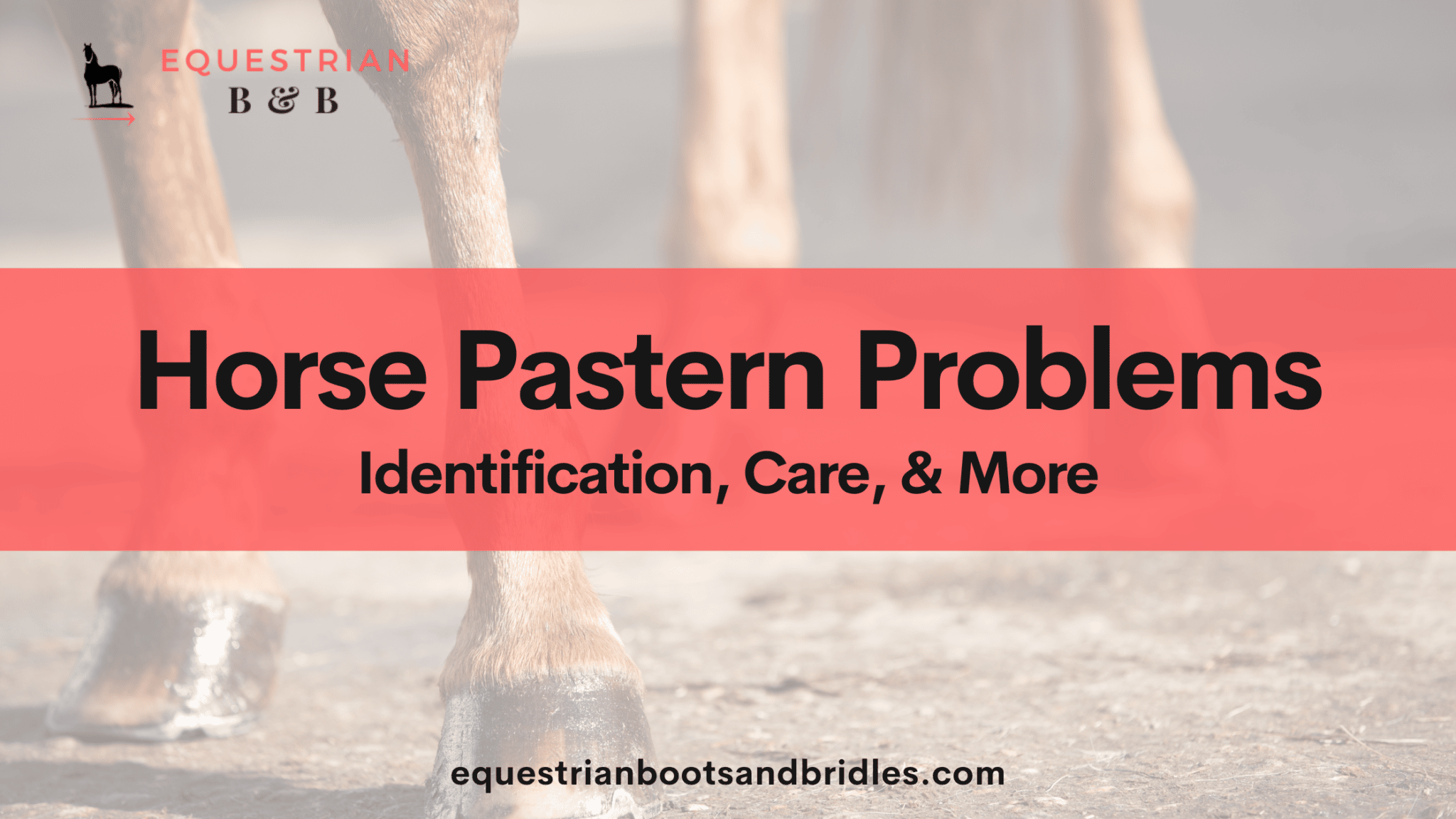Ringbone, sidebone, and a broken pastern… These are words that can strike fear in the heart of every performance rider. Horses are incredibly strong and agile creatures, but their huge bulk (usually over a thousand pounds of it) rests on the equivalent of toothpicks that attach their hooves to their powerful legs.
These toothpicks, aka pastern joints, are incredibly delicate mechanisms that help the horse’s movement while serving the horse day after day without fail… until they don’t! It’s time to learn about your horse and their pastern joint surfaces and how to keep them sound.
This information is meant to be educational only and is not meant to be medical advice. You should always get the help of your vet whenever your horse is having problems.
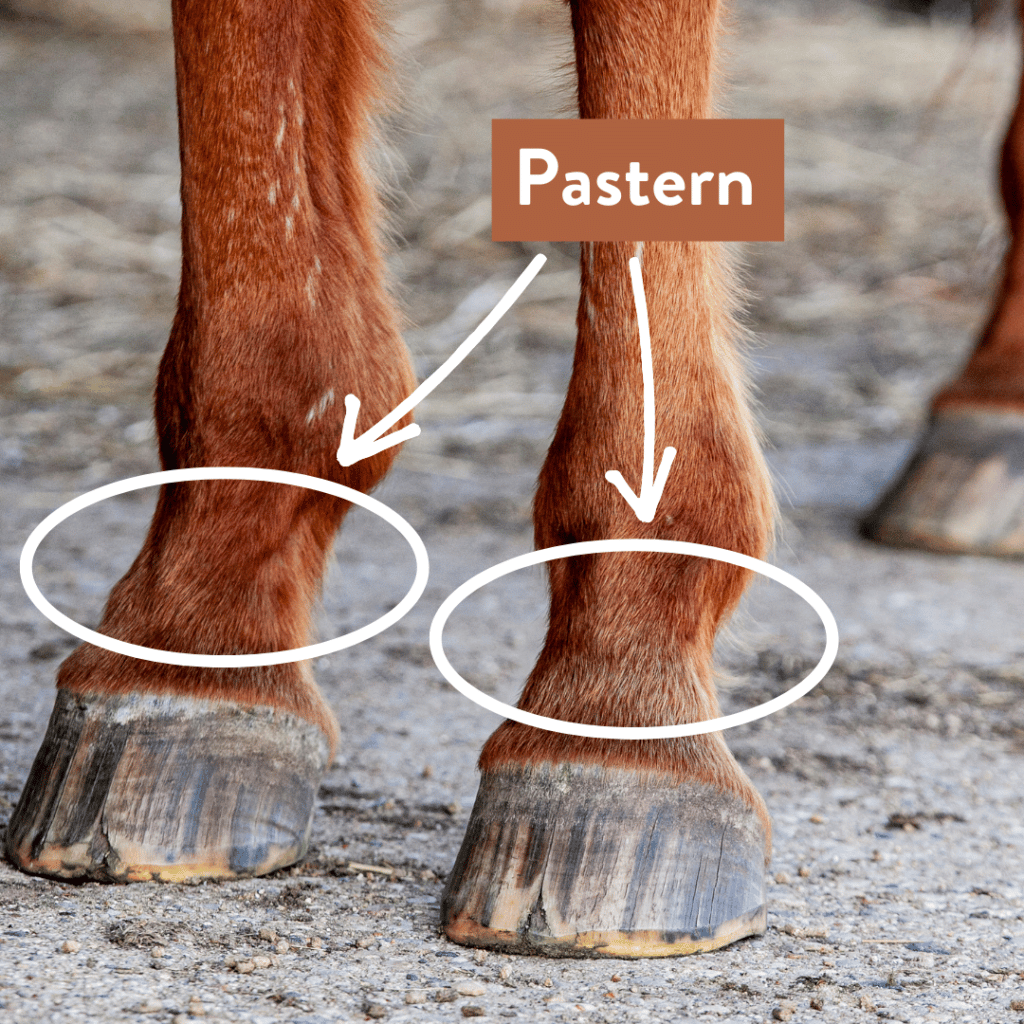
What Are Horse Pasterns?
Horse pasterns are the connective joints between the fetlocks and the hooves. Pasterns are your horse’s “finger” bones. Horses effectively run on the remainder of their thumb and index fingers that have fused into the hoof. The two longest phalanges or phalanxes of the horse’s “fingers” are fused into the pastern.
Each horse has four pasterns: two on the front legs and two on the back legs. Pasterns are supposed to be smooth, yet well developed, as they carry weight and need to be flexible to allow the horse’s hooves to lift and land.
The Performance Horse and Pastern Injuries
Horses that compete and run at speed or jump professionally often suffer injuries to their pasterns due to the excessive impact and injuries. Showjumpers tend to have calcification of the pastern joint due to impact and concussive force over many years. This hastens the onset of arthritis and the formation of side bone formation.
Racehorses tend toward having impact and concussion-related injuries that cause the formation of ringbone.
For a more in-depth explanation of these and other pastern joint problems, read on as I explain how to prevent these problems from affecting your horses.
Identifying Horse Pastern Problems
Identification in the early stages of pastern injuries is vital to help your horse recover from the injury without complications. The key ingredient is knowing your horse’s legs. You should know their shape and texture and also your horse’s stride. When faced with a lame horse, you need to take action immediately.
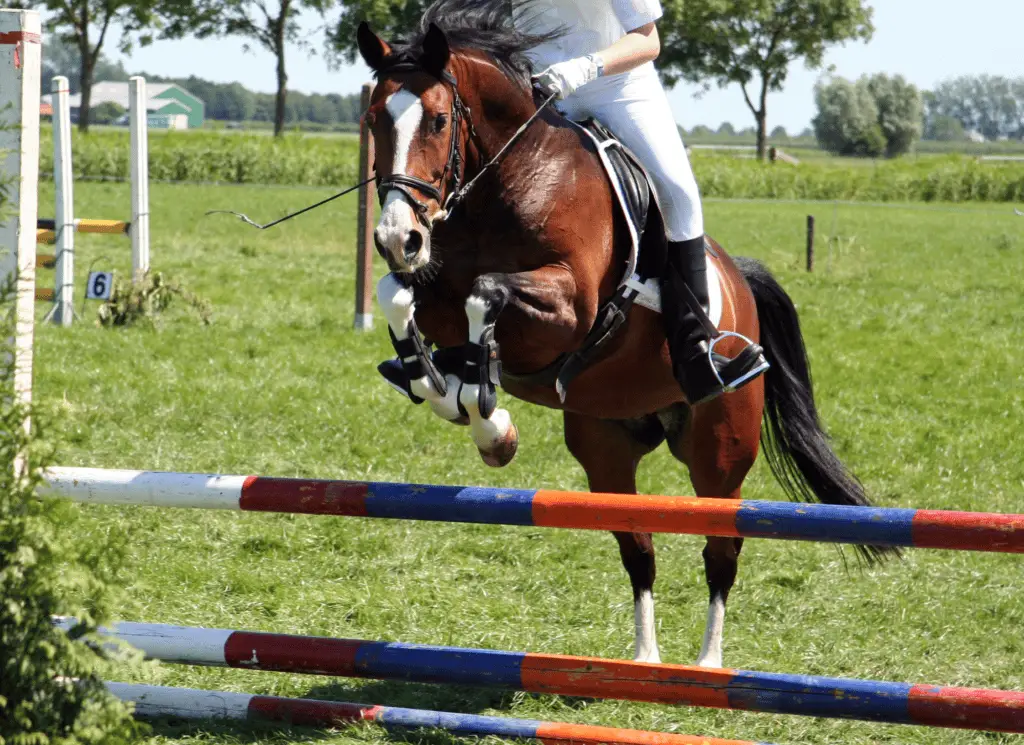
Causes of Horse Pastern Problems
Before getting into the thick of the more technical descriptions of pastern injuries, it’s important to know what causes pastern problems so you can avoid most causes and take appropriate treatment precautions.
- Work over hard surfaces
Horses have sensitive tissue in their joints, and the joint surface can easily become damaged by high impact and heavily concussive striding. Cantering or trotting on a hard surface can also worsen a predisposing factor or prior injuries.
- Falls
When horses fall, such as from a failed landing following a jump, they can twist and fracture their pastern joint, compress the pastern joint, and even rip a tendon sheath. This may present as soft tissue swelling, heat, and severe lameness.
- Knocks, bumps, and other impact causes
Bumping the pastern region, overreaching and stepping on the heel bulbs can severely affect conditions such as upright pasterns and existing fractures or cause issues with bone formation in young horses.
- Injuries
Lacerations, punctures, and infections can cause substantial damage like soft tissue swelling to the pastern area. Increased heat from pastern injuries can cause overheating of the connective tissue that cushions the suspensory ligaments. When placed under further strain, longitudinal tears can occur.
- Genetic Causes
Genetic factors such as upright pasterns, boxed hooves, and malformation of the hind limbs can all contribute to increased risk of pastern and ligament injuries due to an increased pressure being placed on these sensitive areas.
- Diet
Young horses are especially sensitive to poor feeding during their developmental years. If fed incorrectly on low protein and high sugar diets, there is a risk of incorrect new bone formation and early onset of laminitis.
In turn, these issues can place further pressure on the pastern bones, causing lower leg issues such as twisted bone formation, since these areas are still soft and in development.
With adult horses, overfeeding is the main culprit, as an obese horse’s weight exceeds the carrying capacity of their pasterns.

4 Horse Pastern Joint Problems and Treatment Protocols
Physical examination may not always be sufficient to diagnose which pastern injury or problem your horse has if they suddenly pull up lame. Even x-rays may not show in sufficient detail what the extent of damage is, so vets tend to follow a conservative treatment protocol when first diagnosing the following conditions.
A reserved treatment protocol involves box rest, anti-inflammatory and pain medication, and supportive bandaging or casts. If, after a period of rest, there are still signs of lameness that x-rays don’t explain, then a CT (computed tomography) scan may be required to form a differential diagnosis.
1. Phalanges and Proximal Sesamoid Fractures
Signs: Sudden lameness (usually in the hind limbs), swelling, and sensitivity to bending of the fetlock joints.
The long pastern bone of the hindleg is often where small chip fractures form at the back of the pastern. Prolonged and hyper-extension of the legs from running at high speed is usually the cause of these fractures.
Treatment: During assessment, x-rays, nerve blocks, and flexion tests are used to make a diagnosis. Treatment may be surgical by removing chip fractures, aligning longitudinal fractures with two screws, and followed by up to 12 weeks in a cast to give the pastern bones time to recover.
2. Ringbone Formation
Signs: Sudden lame horse with swelling of the pastern region
Horses in intense work, such as young thoroughbreds that are worked hard from a young age on hard ground, may contract this condition much more frequently. The constant jarring impact of the hooves with hyperextension of the legs during racing and jumping causes inflammation of the connective tissue that surrounds the pastern joint.
Injuries and wire cuts can also cause infection and inflammation with the same result: the formation of bone spurs. These bone formations can cause severe pain and lameness. Osteoarthritis may also present when the joint surface becomes compromised. Flexion of the fetlock joint increases pressure on the pastern region, resulting in an increase of pain.
Treatment: Early identification via x-rays will confirm the diagnosis, and long-term rest may help alleviate symptoms and give the horse’s pastern bones time to settle. The bone formation may stabilize, reducing the pain, and the horse may become sound.
In serious cases where the joint space is compromised due to bone formation, surgery may be the only option. Fusing the two bones of the pastern will eliminate pain, though the horse’s ability to race and jump competitively may be seriously affected.
3. General Ligament and Soft Tissue Injuries in the Pastern Region
Signs: Sudden onset of lameness with sensitivity to palpitation of the ligaments and flexion of the fetlock joint.
Aside from the obvious risk of bone fractures such as described in the section on ringbone and phalangeal fractures, tendon injuries are the next culprit in pastern injuries. When tendons become hyperextended during hard work such as from racing, Western riding, and jumping, the tendon sheath may become compromised.
Ligaments such as the digital suspensory ligament or other parts of the suspensory apparatus may become damaged, causing inflammation and internal fixation. Collateral ligaments have to work harder to carry the horse and help the pasterns with shock absorption.
Treatment: Definitive diagnosis of ligament injuries requires advanced investigation, but the usual course of initial treatment will involve long-term rest, the administration of anti-inflammatory medication, and specialized shoes to help the horse balance their heel profile and create a more natural angle of the pastern region.
4. Suspensory Ligament Injuries
Signs: Sudden heat and swelling along the back of the pastern accompanied with swift onset of lameness and sensitivity when palpitated.
The suspensory ligament runs the length of the pastern and into the hoof capsule. It supports the attachment of the hoof, while at the same time, facilitating movement. Injuries to the suspensory ligament often happen in the pastern area due to fractures to the sesamoid bones, which produce bone spurs that rub the ligaments, causing inflammation.
The tendon sheath may also be damaged, which will cause joint fluid to leak out, creating future problems with arthritis.
Suspensory ligaments may also present with degenerative suspensory ligament disease (DSLD), which requires specialized management.
Treatment: Rest is the best treatment combined with pain management with anti-inflammatory medication and supportive strapping when necessary. Ligaments take from a few weeks to several months to heal, and the result isn’t always guaranteed. Early return to work and training can cause further ligament damage that may become permanent.

Different Pastern Types and The Common Injuries
Conformation contributes a lot to the horse’s ability to work and remain sound. When horses have elongated pastern bones, there is an increased likelihood of specific injuries due to the additional pressure on a part of the body.
Longer pasterns tend to become weaker due to the longer bones and delicate tendons that are more stretched.
Abnormally short pastern bones have their own challenges that may cause the bones to become brittle and fracture. Here’s what to expect:
Long Pasterns
Your horse may experience more of the following injuries due to a longer pastern bone:
- Bowed Tendons
Because of the extra long tendon structure, tendons may become compromised and contract, bending the shape of the pastern bones. This is much like an overstrung bow that is unable to flex and fire arrows.
- Sesamoid Bone Fractures
The bones of the sesamoids are found at the back of the pastern, and especially the back legs will take strain when the pasterns are too long. Fractures result, which can progress to suspensory ligament strain.
- Ringbone
Because of the weakness of the longer pastern, ringbone formation is more common than is wanted. In particular, thoroughbreds and standardbreds that have conformational tendencies toward longer pastern areas are known to suffer from ringbone. The bone thickens to a bell shape because of the repetitive concussion force that the long pastern bones can’t handle.
Short Pasterns
Shorter pasterns tend to be stronger, unless they are also upright. This is often seen in horses with an upright or fixed shoulder line. The angle of the pastern bone affects its ability to absorb concussions and impact force. Injuries to these pasterns include:
- Sidebone (though ringbone also forms)
- Splinting and bone fragmentation
- Knee injuries that result from pastern compression
- Windpuffs or windgalls
- Increased risk of arthritis
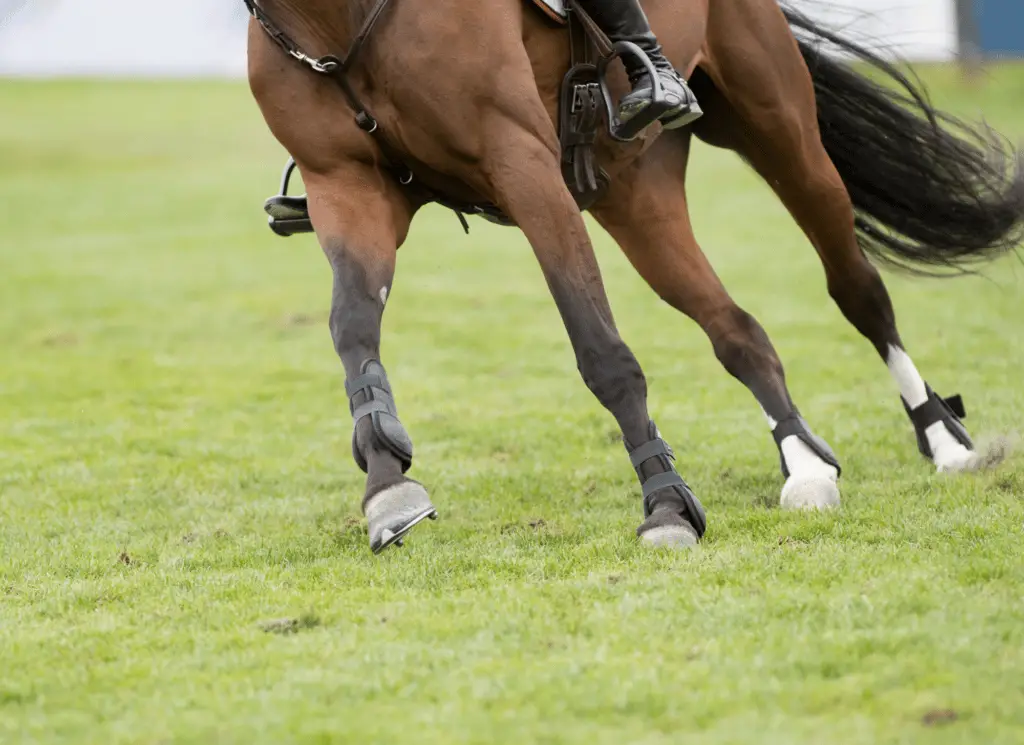
How to Keep Your Horse’s Pastern Region Sound
Horses apply tremendous pressure to their hooves due to training and strain that is often felt by performance horses. Damage to the sensitive internal suspensory apparatus may not be visible to the naked eye, which is why checking different pressure points and immediately taking the horse out of work is vital for a swift recovery.
Tendon and ligament structures are sensitive to compression and the bearing weight of your horse. The angle of the shoulder should match the horse’s pastern bone to help limit excessive shock absorption.
Inspect your horse(s) daily for signs of sudden change to the pastern region. Work with a professional farrier to help determine whether there are predisposing factors such as underrun hooves that may trigger injuries.
Feed your horse a diet rich in the nutrients needed for good joint health, such as collagen, MSM, chondroitin, and the necessary omega oils.
Finally, pick your horse’s terrain and train with care. A great horse trainer and Olympic rider once told me that a horse has only so many jumps in them. While you may enjoy jumping (and your horse does too), it could worsen a predisposing factor and cause any number of pastern and fetlock joint injuries.
Likewise, if you know you are heading out over rough terrain, it is a good idea to discuss appropriate shoes for your horse to help reduce compression and increase shock absorption.
And on that note, ensure you are using the services of a talented and qualified farrier as incorrect trimming or shoeing can seriously compromise the strength and integrity of your horse’s pastern bones.
Treat injuries quickly, taking care of infections and inflammation of the horse’s legs. And choose your horse for the activity they do with great care. A horse with a short pastern bone may experience greater compression, while a long pastern boned horse could more easily suffer fractures and tendon sheath tears since the longer pastern is slightly weaker than a shorter pastern area.
You need to work with your horse’s conformation to structure their work routine according to what they can do.
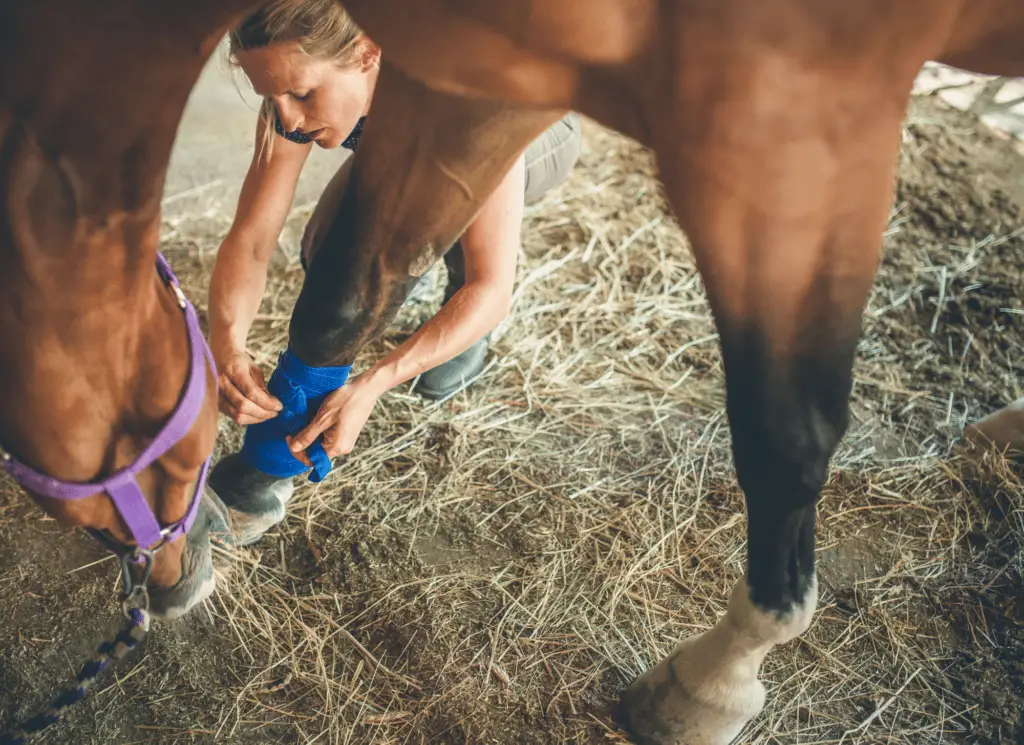
More FAQs About Horse Pastern Problems
What is the pastern in a horse?
A pastern is the area where the long pastern bone passes the coronet band. The pastern area extends to the tissue below the fetlock joint. Within the pastern are two bones that collectively, with ligaments and soft tissues, form the pastern joint. In reality, the pastern is a horse ankle.
What does a pastern do?
The pastern joint is slightly flexible, but its main function is to absorb pressure and impact from the hooves striking the ground. The faster the horse is running or the longer the horse exercises, the greater the damage potential to the pastern area.
How long does it take for a pastern injury to heal?
Pastern injuries frequently suffer reinjury, and some of these injuries may never heal. However, the average time for a pastern bone or tendon injury to heal is anything from 6 weeks for soft tissue swelling to 12 weeks for surgical treatments that require a cast and even 18 months of rest is not unheard of.
Can a horse recover from a broken pastern?
A broken pastern is when the pastern bones or phalanxes are fractured and require surgery or a cast to heal. A horse can recover from many such injuries, but not all. Sometimes, the bones simply won’t heal, or the opposing limb becomes weakened and can’t support the horse during the recovery period.
You’ve heard the old horseman’s adage “no hoof, no horse,” but in reality, this saying means that a horse without a pastern is also doomed. Taking care of this delicate structure (and many more such in the horse) is up to the discerning horse owner.
Learn more about maintaining your horse’s hooves to limit unnecessary pressure on their pastern joints by reading up on overgrown hooves.
Like this post? Save it on Pinterest. Follow me on Pinterest.


